Patagonia has long been an obsession of mine and one where I’ve covered a fair distance, having traveled across the years from the very northern limits of Puerto Madryn and Puerto Montt to the southernmost settlement, Puerto Williams.
The variety of landscapes, ecosystems, and cultures is one of the reasons I’ve continued to return and I’ve become a huge advocate for exploring beyond the region’s big hitters: the Torres del Paines, Perito Morenos, and Fitz Roys.
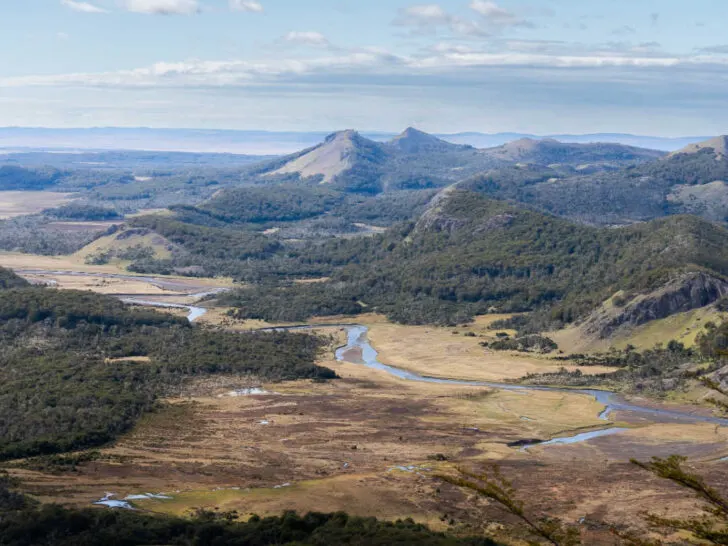
But there’s one area that I’ve always been conscious of not covering in my articles. I traveled deep into the heart of Chilean Tierra del Fuego close to eight years ago and yet I’ve barely written about my experience.
A lack of infrastructure and unreadiness for tourism is what, after much deliberation, kept me from writing about the region, even though the experience was one of the most incredible I’ve had in Patagonia.
A lot of readers visit Patagonia with a particular expectation in mind: a place of untouched beauty far from tourists and human impact. But the reality is often very different. The trails of the W in Torres del Paine, for example, are being eroded by the huge numbers of tourists who traverse them each day.
While there are activities you can do in Torres del Paine or seasons when you can visit that allow you to escape other tourists (winter in Torres del Paine is a completely different experience, for example), the reality remains that for few visitors, this expectation of a region barely touched by tourism is rarely the experience.
Enter Tierra del Fuego.
Most tourists head to Ushuaia, Argentina – and Patagonia’s – southernmost city and the jumping-off point for Antarctica. It’s a large place by Patagonian standards and, while it has access to some beautiful national parks and natural attractions, it’s as close to a metropolis as you’ll find in the region.
But the Chilean side, due to the fact that there are just two roads in and practically no human habitation except a scattering of old-school estancias (ranches), is a completely different story.
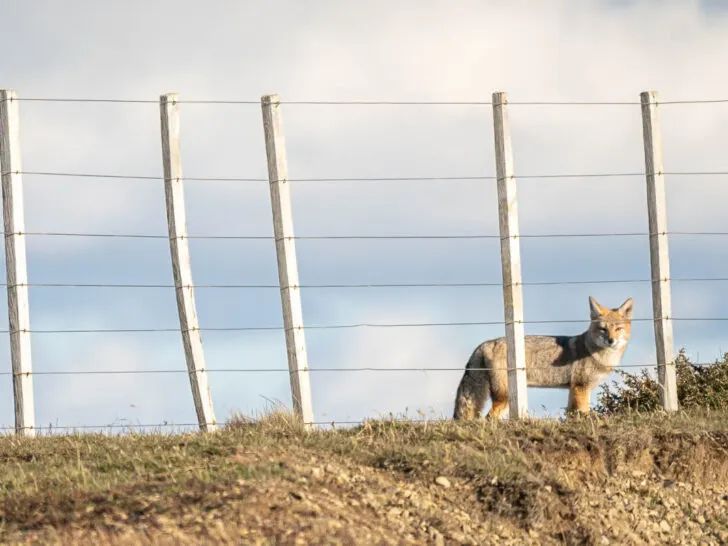
From the north of the island, you might be fooled into thinking it’s covered entirely with Patagonia steppe. But the deeper you drive south, the toothy peaks of the Cordillera Darwin reveal themselves, interspersed with crystalline lakes, rusty-colored peat bog, and old-growth forests of southern beech.
Unlike on the continent, there are no pumas here, so guanaco populations are large. Wild horses – known as baguales – will watch you across the plains, red and grey foxes will zip across the dirt road in front of you, and armadillos will meander past or, in my case, pose for a photo in the sunshine.
The most visible of the wildlife, however, is the beaver. Introduced following a failed attempt to breed them for their pelts, beavers were released into the wild and quickly began an extensive campaign of colonization.
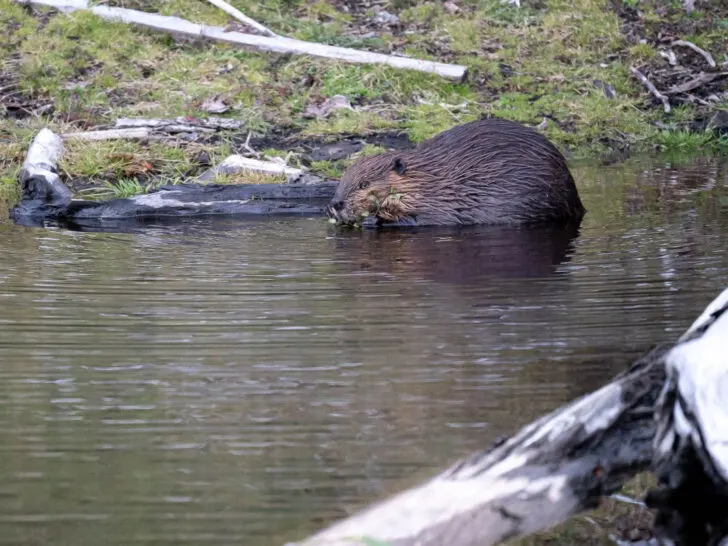
The impact of the beavers is stark. Tracts of forest have been reduced to naked, dead tree trunks that have been waterlogged by the diversion of rivers or the creation of pools by the beavers’ incessant pursuit of dam building.
It’s hard to estimate the impact of this damage, while it’s simultaneously difficult to not find yourself excited by seeing them in the wild – which is itself a frequent occurrence.
Even deeper into the mountains, you’re rewarded with some of the region’s most beautiful fjords, many surrounded by glaciers so remote that barely anyone has the chance to go there.
Nearby, a small number of families, who have lived in this remote, enchanting place since the 1960s when there wasn’t a single road, continue to etch out a living at the very edges of the earth.
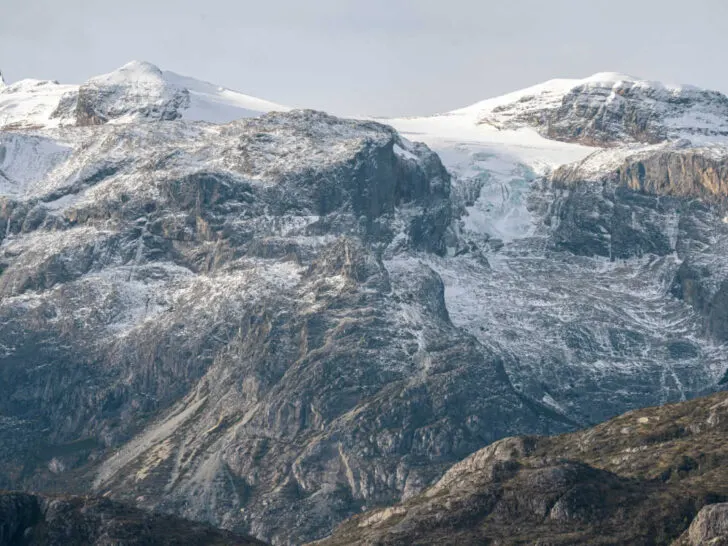
They have remarkable stories to tell about their lives and the experience of living in Tierra del Fuego. It is humbling to hear about life in such an unforgiving environment.
So why am I writing about Tierra del Fuego now? When I first visited, it was to drive to the very end of a road that aims to reach the Beagle Channel, which marks the southern edge of the island.
This project was a decade away from completion when I visited eight years ago – and little progress has been made, if predictions that it’ll still be a decade until the road is finally in place are to be believed.
Last time I visited, I wild-camped alongside remote lakes and watched the beavers build dams on the side of the roads. I was deeply enchanted by the area but felt it was irresponsible to promote a place so far from ready to receive tourists.
But this is changing. A few years ago, I met the manager of Lodge Deseado. This remote hotel is located on the very same lake, Lake Deseado, where I wild-camped on my first visit to the area and is pioneering tourism in the region.
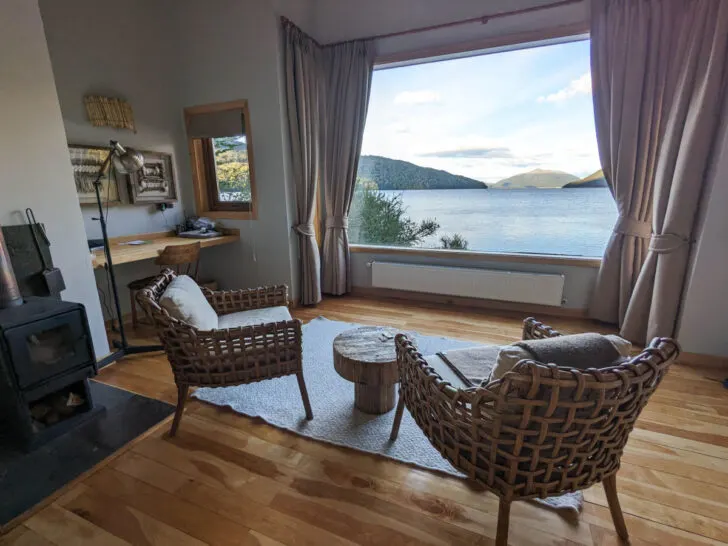
There are just nine cabins and space for 18 guests in beautiful cabins constructed using locally sourced lenga and with huge windows granting sweeping views of the lake.
The lodge is not cheap (all-inclusive rates with tours starting from $800 USD per night for two people) – but their approach to tourism and the experience they offer is one that manages to bring visitors to this magical place while still being sensitive to its pristine state.
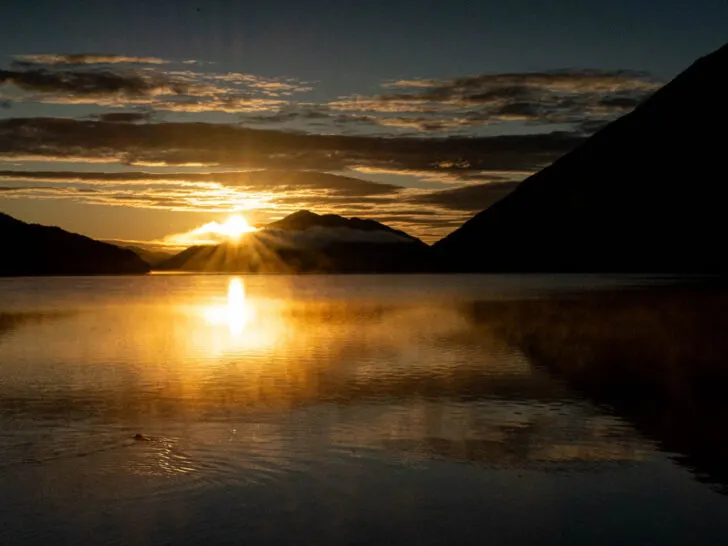
The setting is spectacular. I woke each day to a front-row seat of sunrise climbing over the lake and went to sleep beneath some of the clearest, brightest skies I’ve ever seen.
Kayaks are available for trips out on the lake, while a zodiac can take you to a new trail they’ve built through funding from CONAF (the Chilean body that administers national parks) across the water.
It’s also positioned in between Parque Karukinka, with its hiking trails and panoramas showing the way the terrain shifts from steppe in the north to icy mountains in the south, and Cordillera Darwin further south.
There you can take a boat trip out to Glacier Parry, which I’ve been told is outstandingly beautiful (I’m already determined to return to visit it!), or meet Don German and his wife Marisela, the couple who live at the very end of the road.
They have a truly remarkable story of settling their land when access was on horseback and you would go months without any sort of contact with the outside world.
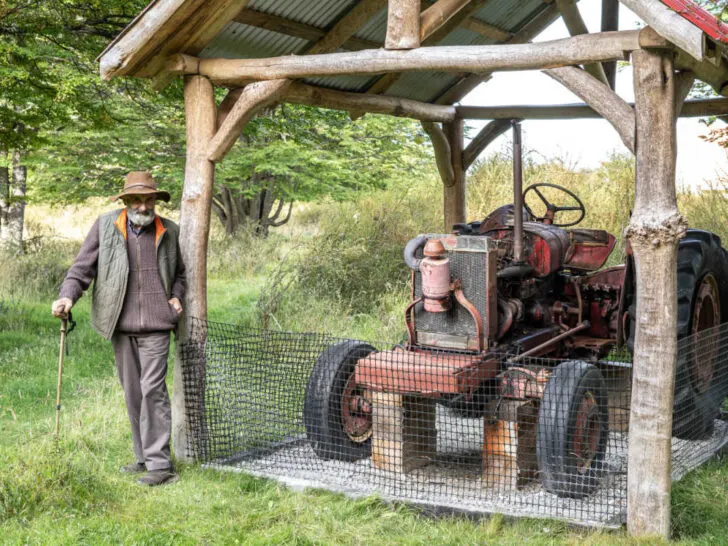
Chilean Tierra del Fuego is a magical place and one that needs sustainable, considered tourism to protect it. When the road is finally finished, tourism is set to increase exponentially; it’ll be a short boat trip from Ushuaia to the Chilean side of the island where the road will terminate, bringing the kind of mass tourism that the region is, as yet, ill-equipped to handle.
The lodge hopes to be a major player in those discussions and I’m confident they can help support the community in navigating what will be a huge change to their way of life.
In the meantime, now is definitely the time to explore the region before the inevitable happens. Sure, Chilean Tierra del Fuego is no Torres del Paine, but a trip here is the perfect way to finish an adventure in Patagonia: by seeing it almost exactly the way that it has been for centuries.
Visiting Lodge Deseado
Lodge Deseado isn’t the only accommodation in the area (I’ll get to that), however, it is the most comfortable and the sole choice locally with guides and organized activities.
Hotel manager Jorge and his small team work hard to provide an “en casa” experience that isn’t stuffy like other high-end lodges can become, but one that allows for fascinating conversations about the region, its culture, and customs.
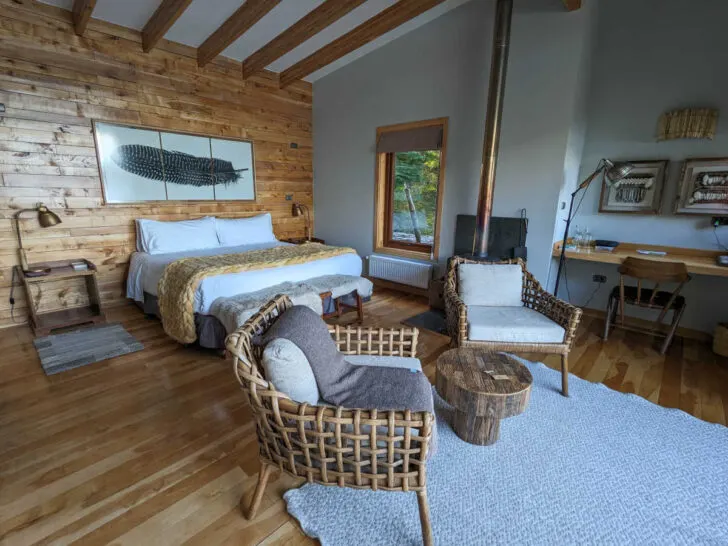
The majority of lodge staff are also from the Magallanes region, so have plenty to say on the topic of Patagonian identity and what it means to live this far south.
The food is a standout aspect of the lodge. Thanks to a nifty use of technology involving the cooking and freezing of dishes in Punta Arenas to be transported to the lodge and reheated (without any negative impact on the flavor), the food is phenomenal.
Plenty of classic Chilean and more regional dishes are on offer – including guanaco carpaccio and guanaco steak, chupe de centolla and cachayuyo ceviche. You’ll find plenty of vegetarian and vegan options, too.
Desserts are well represented here as well: you’ll find Calafate cheesecake, mate creme brulee, and other regional flavors, while Chilean wines and regional craft beers have been carefully selected to accompany the rest of the menu. If my experience is anything to go by, you won’t be leaving hungry!
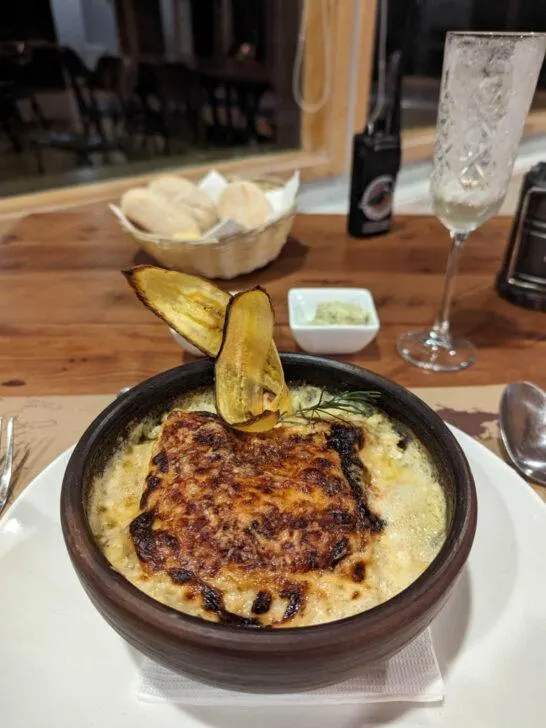
The lodge isn’t cheap but for the quality of service and its extremely remote location, I think it provides good value for money – particularly compared with similar high-end lodges in Torres del Paine that will set you back eye-watering amounts (Explora charges $10,000 for three nights in high season…!).
A really important thing to be aware of is that the lodge is extremely remote – which means a long journey to get there. From Punta Arenas, it’s an eight- or nine-hour drive (including a 40-minute ferry journey across the Magellan Strait that can often be delayed and add extra time to your journey), with most on gravel roads.
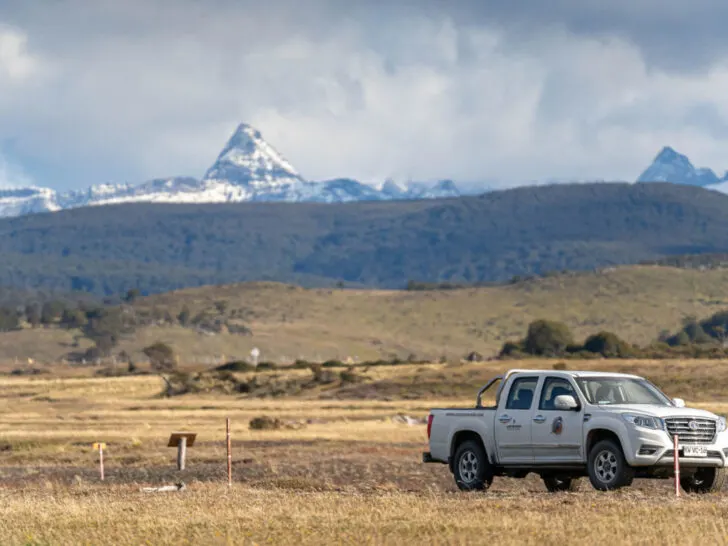
The landscapes at the very top of Tierra del Fuego aren’t particularly exciting – think unending grasslands dotted with sheep – but as you venture further south, mountains appear and your chances of spying native wildlife increase, too.
Yes, it felt like a long time in the car, but we spotted so many animals (an armadillo, three or four red foxes, three grey foxes, rare birds of prey, and two beavers, plus a pod of Chilean dolphins accompanying the ferry across the Magellan Strait), that the time passed remarkably quickly.
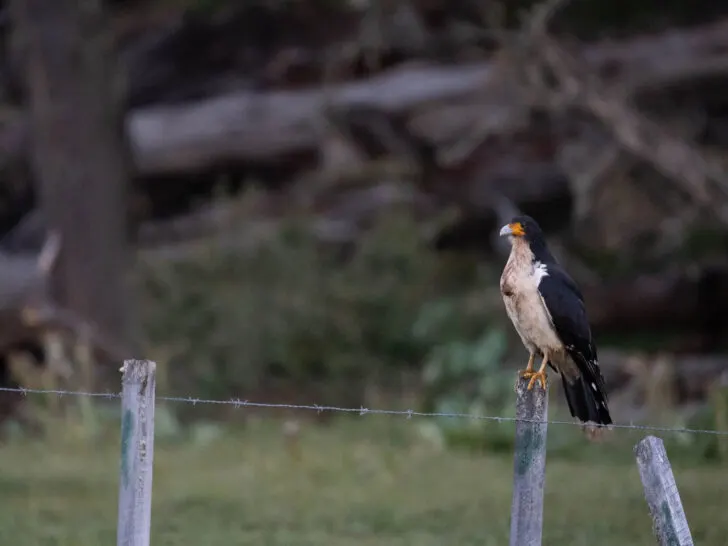
The hotel charges $800 USD to bring you from Punta Arenas to the lodge; if you’re feeling adventurous, you could rent a car in Punta Arenas and drive instead, but you’ll need a 4WD and experience driving on unpaved roads. In rainy weather, the route can be treacherous.
If you’re coming from Ushuaia, the trip is much faster: around five hours, including a quick border crossing at Bellavista, a remote, rarely traversed border an hour north of the lodge. I was charged $300 USD for the transfer between the lodge and Ushuaia.
Lodge Deseado currently has a promotion exclusively for Worldly Adventurer readers: for bookings in November and December of this year, and April of 2025, if you book three or more nights at the lodge, you’ll receive a 15% discount on your stay. You’ll need to use the code ‘STEPH24-25’ – and bookings must be made before June 30, 2024 to secure this promotion. Contact them here.
Tips for visiting Tierra del Fuego independently
What if you don’t have the budget for such an expensive lodge? I explored Chilean Tierra del Fuego on a bootstrap on two occasions and it is possible.
Many of the activities you do at Lodge Deseado you can do independently, you’ll just need to plan carefully: this is a remote place and if your car breaks down or you have an accident or emergency, you are far away from help.
So what should you do in Tierra del Fuego?
Stop by the king penguin colony at Bahía Inútil
I have been obsessed with penguins since I was a child, so it should come as no surprise that I’ve visited the king penguin colony at Parque Pinguino Rey near Bahía Inútil not once but twice. I also captured there probably my favorite ever animal picture.
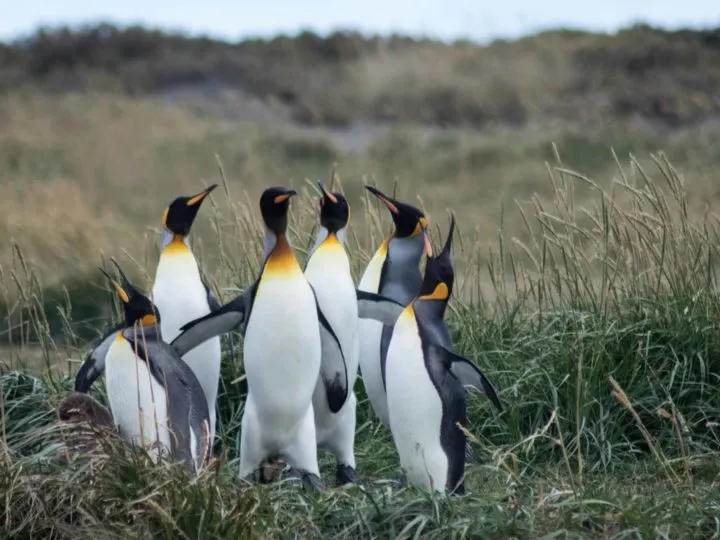
Anyway, I digress. The park is home to around 90 king penguins who started a colony on the western edge of Tierra del Fuego back in 2010. Unlike the Magellanic penguins that you’ll see on Isla Magdalena near Punta Arenas and near Ushuaia, they don’t migrate, so you can visit them year-round.
You can get within a few hundred meters of the birds (bring a telephoto lens if you want good photos) and you must book your ticket in advance ($15,000 CLP); they sell them by slot, so you’ll have a specific time you need to arrive by.
Hike in the wilderness of stunning Parque Kaukinka
This privately owned park protects 300,000 hectares (74,000 acres) of land, of which only a small tract is open to the public. Four hiking trails allow you to enjoy the diversity of the Tierra del Fuego terrain.
I personally really enjoyed the hike up to Pietrogrande, where you have 360-degree panoramas encompassing the steppe to the north and the Darwin Mountains to the south.
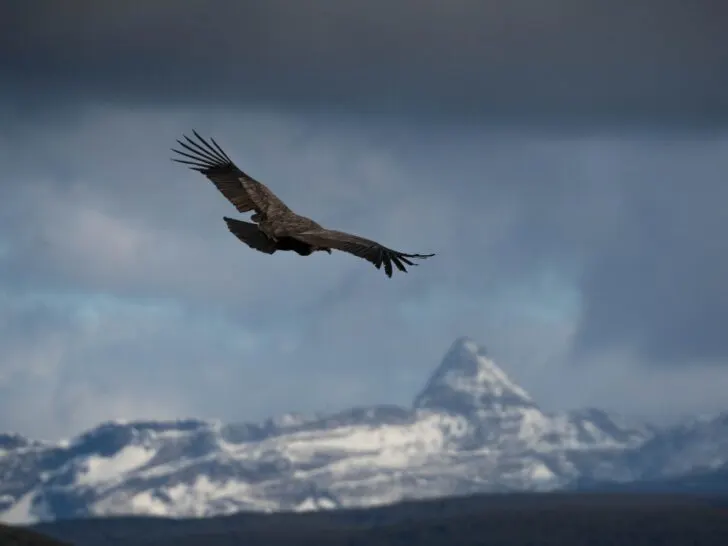
Condores Imaginarios (Imaginary Condors) was also a very short but rewarding hike up to the summit of a hill; from the top, you can see across the peat bog of the valley below and we discovered the condors weren’t imaginary after wall, getting the change to watch a couple catching the thermals above us.
Drive to the very end of the road, dreamy Caleta Maria
Marking where the road hits the edge of the Almirantazgo Fjord, Caleta Maria was the region’s main entry point when it was used by a lumber company that constructed an incongruous airstrip here back in 1943.
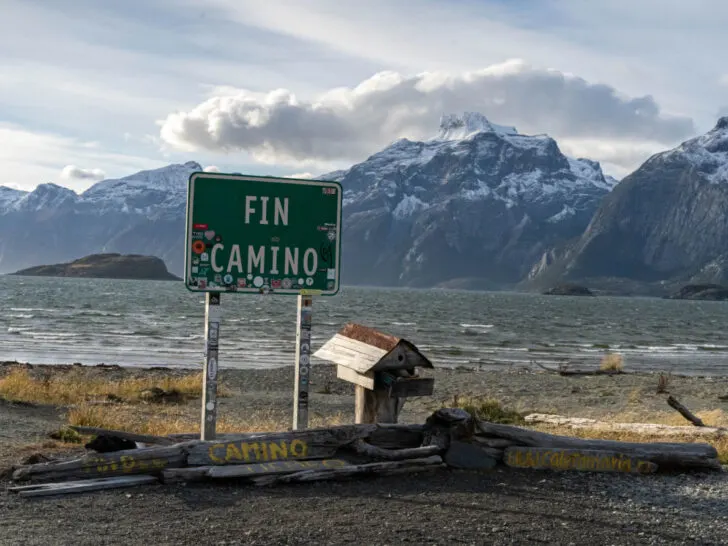
Nowadays, it’s mostly abandoned except for a sign marking the “Fin del Camino” (End of the Road), where visitors have begun engraving pieces of flotsam with their names and the date of their visits.
Just before the signed turning for Caleta Maria, you can drive another kilometer or so to the official end of the road where construction is continuing to join it to the Beagle Channel at the very bottom of Tierra del Fuego. There’s nothing here, except another sign saying “Fin del Camino”.
Visit the stunning Glacier Parry and a colony of elephant seals
Sadly, this was something I was unable to do because the guy who operates the tours was not around, but I’ve heard it is the absolute highlight of the region, with a chance of spotting elephant seals nearby.
Glacier Parry is impossible to visit from anywhere else but is a short trip away by boat from Caleta Maria. The guy who runs the tours is Juan (Pechuga) Bahamondes and you can contact him to book through his Instagram.
Take photos of the snow-capped Cordillera Darwin
The Darwin Range marks the very tip of the Andes Mountains and is a delightfully craggy strip of peaks that are rarely ice-free.
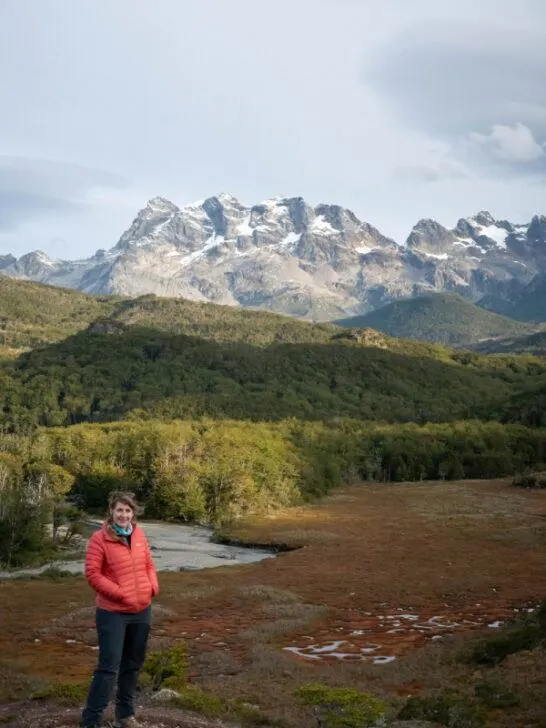
There’s a beautiful viewing point just a few kilometers before Caleta Maria where it’s well worth stopping to take photographs.
Encounter native – and invasive wildlife
Not all of the wildlife that you can find in mainland Patagonia has made it across the Magellan Strait, but those that have are far easier to see than further north.
Guanacos and foxes are abundant, as are birds of prey, including rarer species such as the white-throated caracara. Beavers are also a common sight; you’ll soon notice the flooded areas they’ve built beside roads. Stopping and watching for signs of life will often pay off.
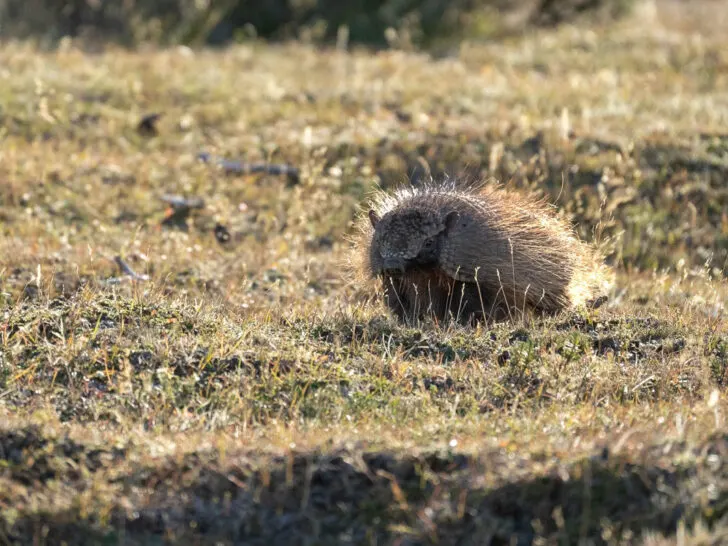
Finally, I was delighted to see an armadillo on the drive to Lodge Deseado – something I’ve never managed before in Chile.
How to plan an independent trip to Chilean Tierra del Fuego
Firstly, you’ll need to hire a 4WD in Punta Arenas. As mentioned above, the roads are gravel, so experience driving in such conditions is helpful – particularly as the rain can make the journey tough going. The cost of renting in Punta Arenas isn’t cheap; expect to pay from $100 USD per day.
From Punta Arenas, it’s just over a two-hour (171 km/106 mi) drive to reach Punta Delgada, where the TABSA ferry ($19,000 per vehicle; passengers free) crosses from mainland Chile to Bahia Azul on Tierra del Fuego through the Magellan Strait.
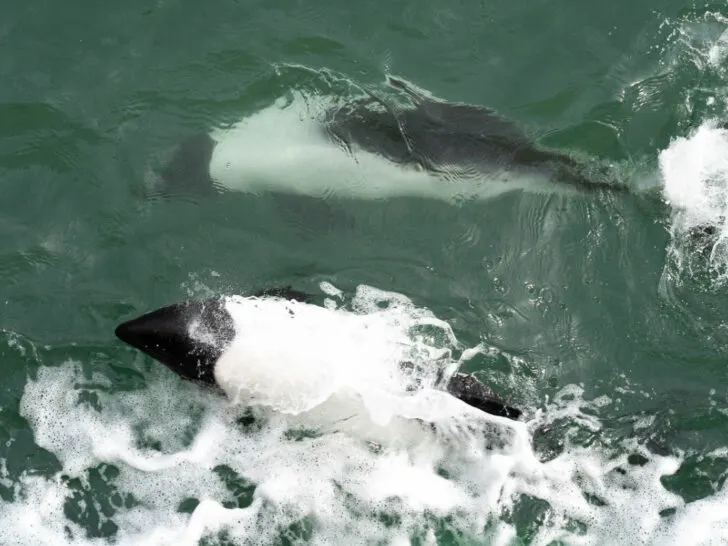
These ferries depart every 20 minutes or so between 8.30am and 1am, although if there’s bad weather, then you can find yourself waiting for hours before the conditions are safe for the ferries to sail.
Next, you’ll need to consider fuel. Fuel up in Cerro Sombrero, 30 minutes (42 km/36 mi) south of Bahia Azul. From there, the only other gas station is at Russfin, a lumberyard 165 kilometers (102 miles) south, which has sporadic opening hours and expensive fuel. There is nowhere else to buy fuel beyond this point – and, if you break down, your hire car will not be able to help you.
When I drove to Tierra del Fuego, our landrover broke down about five kilometers (three miles) from the ferry dock.
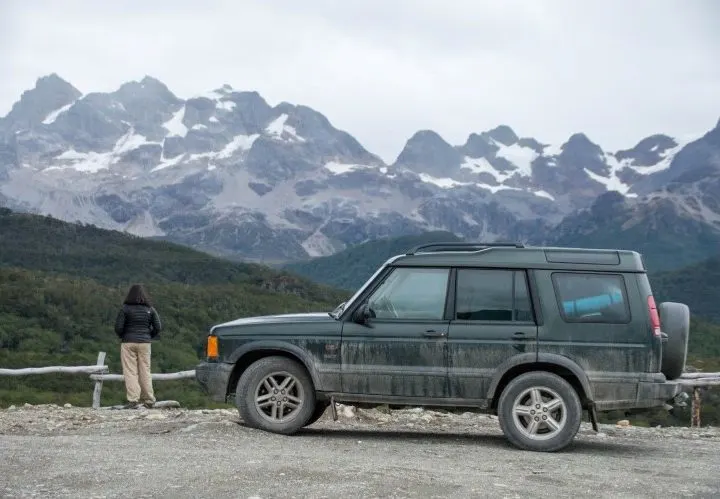
The rental company could only help us if we made it back onto mainland Chile – cue a nailbiting tow by a local guy in a truck, who didn’t feel a need to slow down while towing our vehicle. A memorable experience it was.
You’ll also want to bring all food, as there are no shops beyond Cerro Sombrero, and even those in this tiny town are basic. UNIMARC in Punta Arenas is the best place to pick up food for meals – and, if you’re lucky, they can have massive sales on wine, too.
When it comes to accommodation, there are a couple of alternative options:
Cabañas Lago Blanco
Very close to Hosteria Las Lengas, Cabañas Lago Blanco has great reviews on Google but I’ve never visited them. They don’t have kitchens but do offer meals (which guests have said were brilliant!). You’ll have to reach out to them for prices.
It’s only 30 kilometers (19 miles) from Parque Karukinka, one of the island’s star attractions, making it a great base.
Refugio Vicuña, Parque Karukinka
Within the park, Refugio Vicuña has basic lodgings in a five-bedroom guesthouse ($35 USD double) with kitchen access, 10 campsites ($15,000 USD), and two-person domes ($30,000 USD) on raised platforms (bring a sleeping bag and mat).
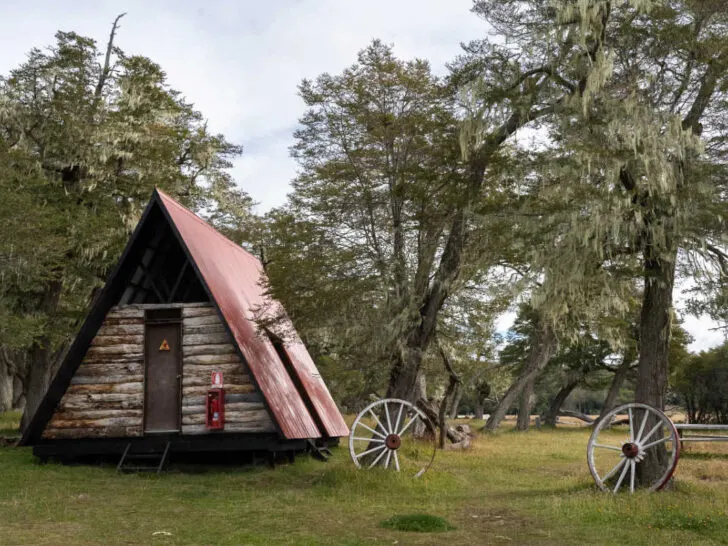
The campsites and domes have access to toilets and covered areas for cooking. Bring all food and a gas stove for cooking, and make sure to reserve ahead of arrival as they are popular.
Estancía Lago Fagnano
Close to the very end of the road and on the edges of the vast and beautiful Lago Fagnano, Don German and his wife Marisela welcome visitors to their small but cozy cabins, which they’ve built on the land adjoining their own cabin.
The accommodation at Estancia Lago Fagnano is decent. You’ll find cabins with equipped kitchens, plus wood-fed stoves for keeping warm, It’s a special place and it’s worth visiting if only to hear tales of life BR (Before the Road) from the family.
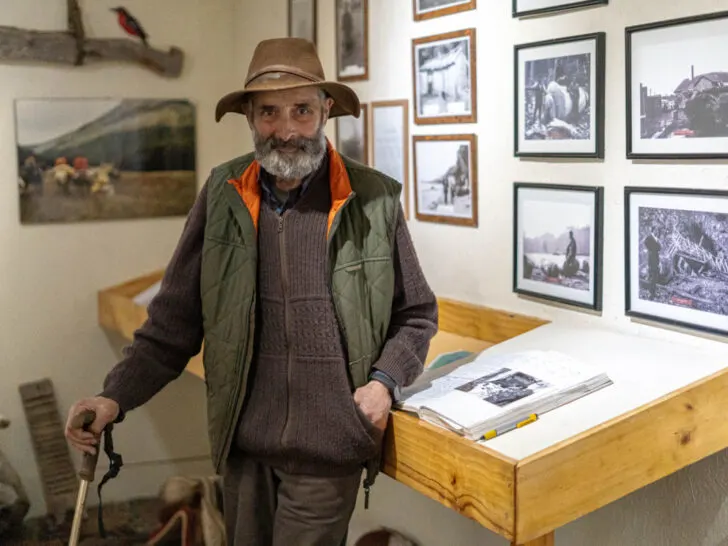
They’ve even built a small museum that you can visit to learn about the family’s remarkable story of moving to the region, which included an English tractor from the 60s that is now on display next to the museum in celebration of its incredible 50-year lifespan in the extreme conditions of Patagonia.
Lodge Cordillera Darwin
The southernmost of all the accommodations in Tierra del Fuego is Lodge Cordillera Darwin, which sits right on the edge of Caleta Maria. I’ve never visited these cabins, but they look very comfortable and have incredible views across the Almirantazgo Fjord. They offer meals, too.
Wild camping
When I first visited the region, I wild camped on the banks of Lago Deseado and Lago Fagnano, where there are two spots frequently used by visitors. However, issues of waste and rubbish being left by visitors means this is something that I no longer recommend.
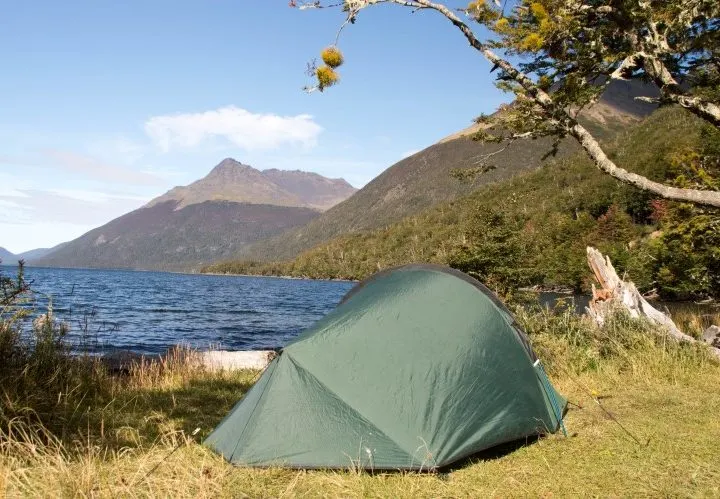
Lighting a fire is also prohibited because of the risk of forest fires (something Chile has increasingly battling in recent years due to climate change and with devastating results), so if you do decide to wild camp, please, please, please do respect local laws and the lives of the surrounding wildlife and people of the region and don’t light a fire.
How to be a responsible visitor to Chilean Tierra del Fuego
Hopefully, it goes without saying but you should take out all of the rubbish you bring with you. Water in the area can carry a virus caused by the beavers in the waterways, so it’s worth bringing a reliable water filter such as the Grayl Geopress to make the water safe to drink.
I was a guest of Lodge Deseado, which covered the costs of staying in their lodge, transport to (but not from) the lodge, plus all meals and excursions. Despite this, my evaluation of the lodge is an entirely objective one, based upon years of experience as a guidebook author and journalist for publications around the globe.
My positive opinion cannot be bought and I only work with companies that I know are doing brilliant things around the region – knowledge acquired across 10 years of living in and traveling around Latin America. You can read my editorial policy for further information.
